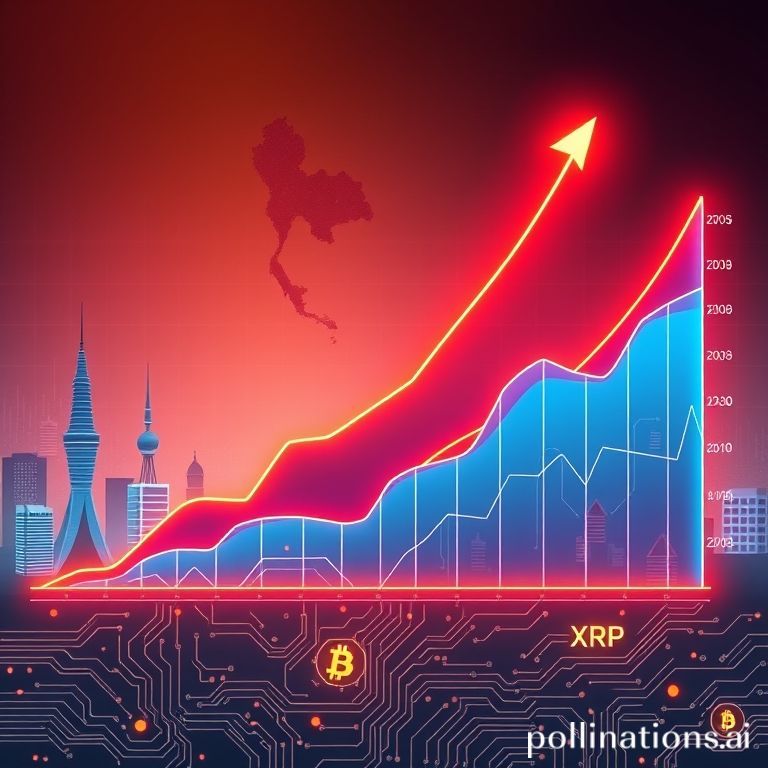
Recent reports from Thailand's financial regulatory bodies and local market analysis indicate a remarkable trend: XRP has emerged as the country’s top-performing asset. For nine consecutive months, this cryptocurrency has consistently delivered the strongest year-on-year returns, significantly outpacing traditional assets like gold and stocks, as well as its digital counterpart, Bitcoin. This extraordinary performance has captured the attention of investors and market observers, prompting a closer look into the factors driving its success in the Thai market.
The figures underpinning XRP’s ascendancy are compelling. The cryptocurrency recorded an astounding gain of approximately 390% compared to the same period last year. This substantial growth is not merely an isolated spike but a sustained trend, affirming its dominant position in the investment landscape. August alone witnessed robust trading activity, with an estimated 299 billion baht, or roughly $8 billion, in crypto trades. Such vigorous market engagement was supported by a considerable base of around 230,000 active accounts, highlighting a vibrant and expanding digital asset ecosystem in Thailand.
Understanding the Dynamics of Thai Retail Investment
A detailed breakdown of market participation reveals that retail traders play a crucial role in this phenomenon. Approximately 40% of the trading volume in August was attributed to individual retail investors, with institutional players, foreign accounts, and corporate entities accounting for the remainder. This broad participation, rather than reliance on a single major player, suggests a widespread interest among ordinary Thai citizens in digital assets. The data, replicated across various financial outlets, underscores a grassroots movement within the country's investment community, reflecting growing digital literacy and an appetite for alternative investment vehicles.
The unique confluence of cultural factors, technological adoption, and a relatively progressive regulatory stance on digital assets in Thailand might contribute to this heightened interest in cryptocurrencies. As more individuals seek diversified portfolios and higher potential returns in a low-interest-rate environment, assets like XRP, despite their inherent volatility, become increasingly attractive. The ease of access through local exchanges and the increasing availability of educational resources could also empower retail investors to engage with the crypto market more confidently.
Beyond Price: A Nuanced View of Investment Performance
While XRP's headline-grabbing price returns are impressive, analysts caution against drawing simplistic comparisons. It is essential to understand that price return, though significant, represents only one facet of investment performance. Traditional assets such as stocks and gold are frequently evaluated based on their total return, which encompasses dividends, interest income, and other forms of yield in addition to capital appreciation. Cryptocurrencies, by contrast, typically do not offer such supplementary income streams, making direct comparisons sometimes misleading without considering the broader financial context.
Moreover, the nature of crypto markets means returns can fluctuate dramatically over short periods. A substantial year-on-year percentage gain, like XRP's, can be particularly sensitive to the base price from the previous year. If the asset's price was considerably depressed a year prior, even a recovery to previous levels or moderate growth can translate into exceptionally high percentage returns. This sensitivity to timing and market cycles necessitates a cautious interpretation of performance metrics, reminding investors that past performance is not always indicative of future results, especially in highly volatile markets.
Regulatory Framework and Market Usage in Thailand
The regulatory environment in Thailand also plays a pivotal role in shaping cryptocurrency usage. According to reports from the regulator and market observers, cryptocurrencies in the country are primarily held for investment purposes rather than as a medium for daily payments. While limited pilot programs for specific uses have been explored, crypto is generally not sanctioned as a standard means of payment. This distinction is critical: the restriction on everyday use channelizes much of the market activity towards speculation and investment, inadvertently contributing to sharp price movements and increased volatility, even as broader commercial adoption remains nascent.
The strong speculative interest, fueled by the prospect of high returns, contrasts sharply with the limited practical application of digital currencies in commerce. This unique market dynamic creates an environment where investor sentiment, global news, and market liquidity can exert significant influence on asset prices, sometimes leading to rapid appreciation or depreciation, which might not be directly correlated with fundamental utility or widespread adoption.
Navigating Volatility and Data Reliability
Experts advise caution, emphasizing that the impressive percentage gains should not overshadow the inherent risks. XRP’s surge could, in part, be a recovery from a previously depressed price level, coupled with renewed and intensified interest from retail buyers. Understanding this context is vital for investors to make informed decisions rather than being swayed solely by headline figures. The crypto market's susceptibility to rapid shifts underscores the importance of thorough research and risk management strategies.
Furthermore, the quality and methodology of data collection are crucial. Trade volumes and account counts are often reported by individual exchanges or consolidated by regulatory bodies. However, different sources may employ varying filters, definitions, or reporting standards, which can lead to discrepancies in reported figures. This highlights the need for a critical approach when evaluating market data and relying on verified, authoritative sources to ensure accuracy and transparency.
Anticipating Future Regulatory Landscape
Given the increasing prominence of cryptocurrency trading in Thailand, market observers anticipate greater attention from regulatory authorities. Reports suggest that the surge in trading activity and investor participation could lead to the implementation of tighter rules and regulations. These potential measures would primarily aim at enhancing investor protection, ensuring market integrity, and mitigating potential risks associated with the volatile nature of digital assets. As the market matures, a robust and adaptable regulatory framework will be essential to foster sustainable growth and safeguard the interests of all participants. Investors should remain vigilant and prepared for evolving compliance requirements in the rapidly developing crypto space.
